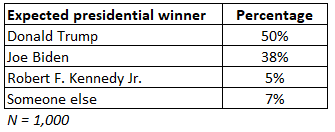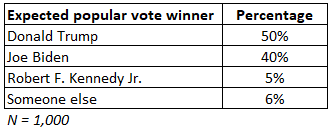| Dear Readers: If we have learned anything from the past couple of presidential election cycles, it’s that one should try to take more factors into account than just horse race polls asking respondents for whom they plan to vote. Debra Leiter and Michael Lewis-Beck, two political scientists with lengthy experience in election forecasting, suggest that the public’s opinion on who is going to win (as opposed to asking respondents for whom they plan to vote) has had some value in both the United States and abroad, although this method (just like any other) isn’t foolproof on its own, as they explain below. Today’s piece provides some background on citizen forecasting as well as polling on whom the public thinks will win in November. Leiter and Lewis-Beck also wrote about citizen expectations for the 2024 election in the Crystal Ball last year, and they plan to provide updated polling information on voter expectations about the presidential race later in the cycle.
— The Editors |
KEY POINTS FROM THIS ARTICLE
— Polling data from this spring showed voters estimating a Donald Trump victory, with Joe Biden’s estimated chance of victory lagging behind.
— Citizens see little difference in the likely winner of the Electoral College and the popular vote for the upcoming election, indicating that this is not simply an institutional assessment.
— These estimates help set a baseline for the impact of the campaign on voters’ estimations of potential victories, and the predictions may tighten as the election draws near.
How the public forecasts the election
While the 2024 presidential contest will not take place for another several months, as the pivotal event draws ever closer, speculation increasingly mounts about who will win. Most media sources turn to public opinion polls as a leading source of scientific prediction, which rely heavily on the vote intentions of respondents for the fall. But while we have frequently relied on voter intentions to make scientific predictions about elections, we should also consider voter expectations about elections, which reflect not just current preferences but beliefs about the future. The deployment of such voter expectations, commonly referred to as Citizen Forecasting (CF), asks citizens to answer a critical question, “Who do you think will be elected President in November?” These questions, which have regularly been asked in the American National Election Study (ANES), have proved to be a valuable guide to election outcomes.
In a foundational paper, as early as 1989, one of us (Michael Lewis-Beck) and Andrew Skalaban demonstrated that aggregated answers to this pre-election survey item dependably generated a rather accurate forecast. Ten years later, in a replication of that study, Lewis-Beck and Charles Tien showed that across 11 presidential elections, 1956 through 1996, voters correctly forecasted the winner in 71%of the cases. The CF method has been applied, to good effect, in the United States and the United Kingdom, as well as Canada, France, Argentina, and Germany. With regard to the 2020 United States presidential election, Gregory Huber and Patrick Tucker were able to use citizen forecasting to accurately forecast the Biden win. Other extensive comparative work suggests more generally that, ceteris parabis (all else equal), voter expectations forecast better than voter intentions . Today we turn again to citizen forecasts to see what voters expect about the upcoming election.
In an earlier comment for the Crystal Ball, we presented a baseline CF forecast of the 2024 presidential contest, from a national survey carried out a year ago. Specifically, the 2023 Verasight MPSA Omnibus Study gathered survey responses from 1,000 U.S. adults, April 19 to April 27, 2023. In this survey, we asked voters “Who do you think will win the 2024 US Presidential Election?” Given the uncertainty around the candidacies, we asked about a range of potential candidates, including Joe Biden and Donald Trump, but also Ron DeSantis, Gavin Newsom, “some other Democrat,” and “some other Republican.” Using these data, we estimated the percentage who expected a Republican win versus a Democratic win, pooling together the Republican and Democratic-aligned candidates mentioned by respondents. (Verasight data are weighted to incorporate standard demographic characteristics and partisanship and their survey sampling technique has a proven record in election forecasting in the 2020 election.) The pooled responses to this question from 2023 are below in Table 1.
Table 1: Expected presidential winner, April 2023 polling

Examining these two-party results, we observe voters were about evenly divided. Approximately 52% of voters surveyed forecast the Republican candidate, while about 48% forecast the Democratic candidate. The ability to point to multiple candidates may have increased citizen uncertainty, leading to about an even spread across the two parties, although even at that point both Trump and Biden were recognized as the likely winners by respondents.
At the distance of more than a year and half from the election, before any candidate had gotten a party nomination, voter expectations might appear to have limited value, and showed that citizens were as uncertain as most forecast models at this point. However, the closer in time to the election, the more accuracy tends to improve in both citizen forecasts and vote intention polls. What can we learn from a second sounding of the citizen forecast, a year later? Consider Table 2, below. This shows the results from a similar Verasight MPSA Omnibus Study conducted April 10-15, 2024, of 1,000 U.S. adults—the question was “In November 2024, which candidate do you think will win the presidential election?”
Table 2: Expected presidential winner, April 2024

We see that former President Donald Trump has a clear lead over President Biden, in terms of voter expectations regarding victory. Certainly the reduction in possible candidates may have helped citizens create a more consistent forecast, although the introduction of a third party candidate means that there are still key similarities to our first sounding. Trump emerges as the clear expected winner, although the percentage of respondents picking him (50%) is very similar to the roughly 52% who expected a Republican victory back in the previous poll in April 2023..Biden’s 38%, meanwhile, is well below the 48% who expected a Democratic victory a year ago.
Beyond that, is this finding an artifact of the particular way the question was worded? For example, the Electoral College itself, which of course ultimately determines the winner, is not mentioned. To assess this possibility, we asked the question in a slightly different way, taking account the Electoral College role and asking voters to predict the popular vote winner: “In the November 2024 US Presidential election, regardless of the Electoral College Results, which candidate do you think will win the popular vote and receive the most votes?
Table 3: Expected popular vote winner, April 2024

We see that this different wording, which appears more complete (and may be considered somewhat more sophisticated) yields essentially the same result. Donald Trump still leads Joe Biden by 10 percentage points, in terms of expectations. Furthermore, that expectation of a Trump victory does not disappear, even if we take into account the possibility of sampling error (assuming a confidence interval around each estimate of approximately +/- 4 still does not close the gap between the two candidates).
Of course, the election remains five months away and, arguably, the campaign has not really kicked in. Reflecting this is a key finding in the Verasight polling, which shows that, in terms of party identification defection, Democrats display a much higher rate than Republicans; respectively, only 74% of Democrats (plus Democratic Leaners) expect Biden to win, while 88% of Republicans (plus Republican Leaners) expect a Trump victory: Republicans are simply more confident in their candidate’s victory. As the campaign accelerates and issues related to former President Trump’s legal problems (most notably his recent conviction in New York) affect voter attitudes, Biden’s party base may grow increasingly optimistic about the current president’s potential for success, and many Democratic voters may return to the fold. Also, the Independents, often the group most responsive to campaigns, may shift their current expectations about Trump, which registered 46% (compared to only 24% for Biden).
The timeline of the campaign itself, with its intensifying dynamic, suggests that the race will tighten. Election polls and citizen forecasts both narrow in on election victories as Election Day draws nearer. These results demonstrate, however, that the Biden campaign has quite a bit of work to do to convince voters not only that they should win, but that they can. It remains to be seen whether voters will shift their expectations as the campaigns intensify, but currently voters expect a rocky road for a second Biden term. As the election draws ever closer, we hope to provide other CF soundings to show how the campaign itself may shift voter expectations and with them, the predictions for the outcome of the election.
| Debra Leiter is an associate professor in the Department of Political Science and Philosophy at the University of Missouri-Kansas City and the secretary- treasurer of the Political Forecasting Group. Michael S. Lewis-Beck is F. Wendell Miller Distinguished Professor of Political Science at the University of Iowa. He has authored or co-authored over 330 books and articles and is a past president of the Political Forecasting Group of the American Political Science Association. |
